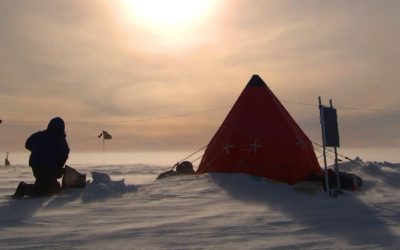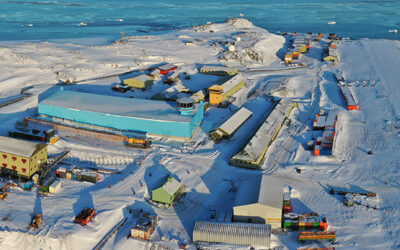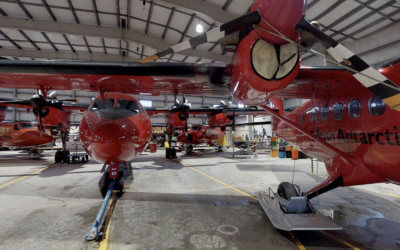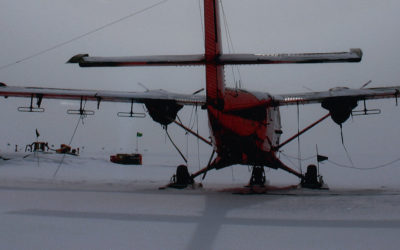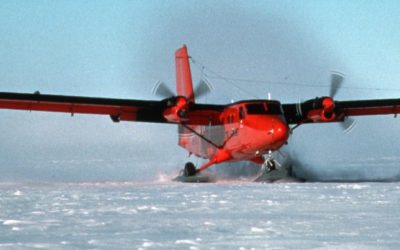
Instrumentation Specifications
Meteorological Airborne Science INstrumentation (MASIN) equipment on the BAS Twin Otter VPF-AZ Total Temperature Goodrich Rosemount Probes mounted on the nose. A non de-iced model 102E4AL and a de-iced model …
BAS operates an instrumented aircraft with a suite of atmospheric instruments and scientific expertise ready to support grants, collaborations, and strategic programmes.
The Meteorological Airborne Science INstrumentation (MASIN) equipment has been flown on the British Antarctic Survey Twin Otter VP-FAZ since 2006, operating out of Rothera, Fossil Bluff, Marambio and Halley in the Antarctic; Longyearbyen and Villum Station Nord in the Arctic.
The instrument suite includes standard temperature and water vapour sensors as well as a turbulence probe allowing full atmospheric profile measurements of temperature, dew point and winds. The fast turbulence probe also facilitates sensible heat flux measurements by the eddy co-variance method. These boundary layer measurement capabilities are complemented by incoming and outgoing radiation instruments and a downward looking infra-red thermometer.
The Twin Otter aircraft has a certified fit of airborne atmospheric instrumentation suitable for atmospheric, boundary layer and cloud/aerosol studies. This aircraft is a very adaptable platform used the world over as a ‘bush’ aircraft. Its twin turbo-prop engines and ‘Short Take off and Landing’ (STOL) capability allow it to be used from small, remote unpaved airfields and the addition of skis or tundra tyres also allows operation on snow and from remote camps.
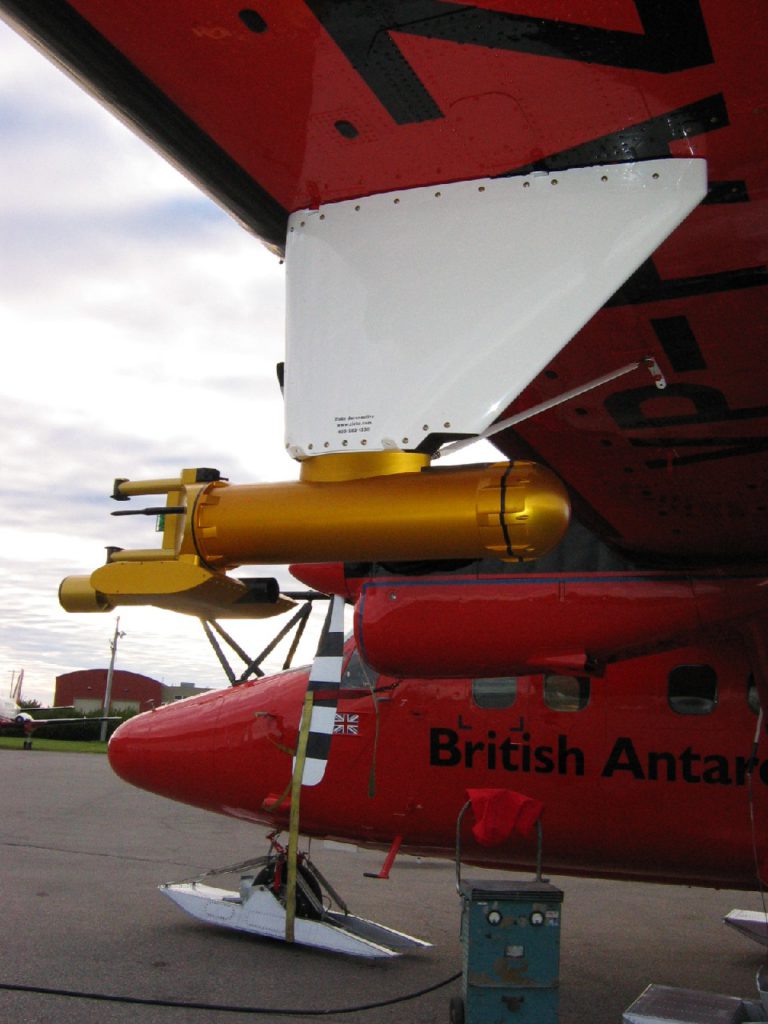
The aircraft can be operated single pilot and a long range fuel tank is also available. Double cargo doors provide good access for installing instrument racks.
In general the aircraft works in the Antarctic from October through to March each year depending on projects. The first Arctic project was with the NERC ACCACIA consortium grant starting from Svalbard in February 2013.
The floor hatch opening can also accommodate a fixed laser range finder or scanning laser which has been used for measuring ice floe topography. The required GPS and attitude measurements to support this are available. Video and digital SLR cameras can also be fitted here. The camera bay can also be configured to drop airborne deployable buoys.
Hard points and pylons are available on each wing. A DMT Cloud and aerosol spectrometer (CAPS) probe is used for cloud studies. Other standard PMS pod instruments can easily be accommodated. We also run a closed path Licor H2O/CO2 instrument, Grimm optical particle counter and cloud condensation nuclei counter fed from simple Rosemount inlets but we are in the process of fitting a Brectel Isokinetic inlet. These inlets provide the possibility of further aerosol instruments.

Meteorological Airborne Science INstrumentation (MASIN) equipment on the BAS Twin Otter VPF-AZ Total Temperature Goodrich Rosemount Probes mounted on the nose. A non de-iced model 102E4AL and a de-iced model …
12 March, 2019 by James France
Dr James France has just completed a week-long flying campaign using one of the BAS Twin Otters fitted with scientific instrumentation. Find out more about his experience.
12 January, 2018 by Jonathan Shanklin
It’s been over 30 years since British Antarctic Survey meteorologist Jonathan Shanklin first visited at Halley Research Station. He’s one of few who has spent 20 Antarctic seasons living and …
3 February, 2023
A team of scientists are currently conducting a major experiment over the Southern Ocean that will help to improve climate modelling. The Southern Ocean Clouds project team are performing several …
17 January, 2020
British Antarctic Survey’s Twin Otter aircraft takes to the skies over Barbados as part of a major international research campaign to enhance understanding of the behaviour of clouds and their …
23 April, 2019
Scientists embark on a three-week flying campaign today (23 April) to study methane emissions from gas fields in the southern North Sea. Using specialised scientific equipment, on board one of …
SOC is a project of the NERC CloudSense Programme The biases observed in climate models over the Southern Ocean in surface radiation and sea surface temperature are larger than anywhere …
The Arctic Summer-time Cyclone Project is a joint project of scientists from the University of Reading, University of East Anglia and the British Antarctic Survey with expertise in atmospheric dynamics, …
physicists, chemists, biologists, economists, and sociologists from 21 institutes in 11 countries across Europe assess the rapid retreat and collapse of Arctic sea-ice cover
PI: Ian Renfrew (University of East Anglia) CO-I’s: Tom Bracegirdle, Tom Lachlan-Cope, Alexandra Weiss PDRA’s: Andrew Elvidge (University of East Anglia), James Pope NERC Grant: NE/N009924/1 Project Partners: Robert Pickart …
JASPER brings together two of the best equipped Polar meteorology instrumented aircraft and teams to study boundary layer meteorology in the Antarctic Peninsula and Weddell Sea. A joint project between …
Long-term meteorological and ozone observations and data help determine the causes of climate change in the polar regions. Meteorology Meteorological observations are made regularly throughout the day at Halley and …
Methane is one of the most important greenhouse gases in the atmosphere, and changes in its concentration could have major influences on the Earth’s climate. Measurements made around the world …
Introduction and Background The largest uncertainties in future climate predictions highlighted by the Intergovernmental Panel on Climate change (IPCC 2007) arise from our lack of knowledge of the interaction of …
Offshore gas fields worldwide are major sources of methane emissions. Developing reliable methods to locate emissions and pinpoint sources is critical for quantifying the volume of methane emissions from gas …
Understanding the Ocean Regulation of Climate by Heat, Carbon Sequestration and Transports
OFCAP is an integrated programme of field observations, analysis and modelling aimed at understanding how the westerly winds in the Antarctic Peninsula interact with the mountains and influence the climate …
PRESCIENT (UK Polar Research Expertise for Science and Society) is a joint programme between BAS (British Antarctic Survey) and CPOM (the Centre for Polar Observation and Modelling). The programme supports …
| Range: | 1000km including skis. Increased with long range tank depending on configuration. |
|---|---|
| Airspeed: | Cruise 65m/s. Data collection 60m/s. |
| Complement: | Pilot + maximum 4 mission operators / scientists. |
| Altitudes: | <35m to 5000m. Unpressurized but with oxygen fit for pilots and operators. |


